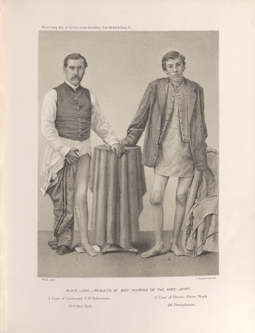Title: Stuck, Peter
Source text: The Medical and Surgical History of the War of the Rebellion. (1861-65.), Part 3, Volume 2 (Washington, DC: Government Printing Office, 1883), 370.
Civil War Washington ID: med.d2e15008
TEI/XML: med.d2e15008.xml
CASE 547.—Private P. Stuck,¹ Co. E, 116th Pennsylvania, aged 18 years, was wounded in the right knee, at Spottsylvania, May 12, 1864, and entered Douglas Hospital, Washington, six days afterwards. Acting Assistant Surgeon H. Gibbons, jr., described the case as follows: "The missile, probably a minié ball, entered at the inner border of the patella and escaped a little external to the center of the popliteal space, going directly through the joint and grooving the articular surface of the internal condyle, but passing mainly through the intercondyloid notch. The patient was a man of delicate organization. He had but little constitutional disturbance and not much inflammation in the joint, which, however, was somewhat swollen. Simple water dressings were applied. The discharge was free, abundant, and thin, the pus being mixed with synovial fluid. On June 9th, there was some loss of appetite, with small, frequent pulse, and the patient complained of pain in the knee, which was swollen considerably. Flaxseed poultices, applied for two or three days, procured a free discharge from the posterior wound (the anterior wound having healed), when the symptoms immediately abated. In the latter part of August the patient began to walk about on crutches, the leg being flexed at an angle of about 135° with the thigh. The discharge was now not so copious, nor the pain at all severe; his appetite was fair, bowels regular, sleep refreshing, etc., as had indeed been the case during the greater part of the time. In the latter part of October, in order to reduce the flexion, the limb was bandaged to a double-inclined plane splint, which resulted in almost entire extension without occasioning any bad symptoms in the joint or confining the patient to his bed. For the following eight months nothing of special interest occurred, though there were several inflammatory attacks, moderate in degree and readily subdued by poulticing. On these occasions abscesses sometimes formed on the posterior thigh. The case is doubly interesting from the fact that the wound only received the ordinary dressing of cold water on cloths, with charpie to absorb the discharge. Tincture of iodine and poultices, or hot fomentations with flannel covered with oiled silk, were used when signs of inflammation showed themselves. No ice was used in the treatment. A photograph (Surg. Phot. Series, No. 63, A. M. M.) of the patient, taken July 9, 1865, is represented in FIG. 2 of PLATE LXVIII. The soldier was discharged from service July 13, 1865, in good health, the posterior wound being still open and permitting the introducing of a probe for three inches. There was also a large deposit of new bone, and the patella was firmly anchylosed to the femur. Some motion of the joint remained." Examiner H. Brubacker, of Somerset, Pennsylvania, certified, September 23, 1867: "The knee is very much enlarged, and the muscles of the thigh are gradually shrinking away. The wound is still discharging pus very freely, and there is evidently some disease of the bones about the joint, which keeps up the discharge." In January, 1876, the same examiner reported: "The joint is completely anchylosed and the leg flexed upon the thigh, so that the heel cannot be made to touch the ground. He walks on the front of the foot. The ball of the foot behind the great toe is enlarged, hardened, and tender, which renders walking very difficult. The leg, including the thigh and hip, is becoming atrophied. His condition is gradually growing worse." The pensioner was paid March 4, 1880.
¹ Circular No. 6, War Department, Surgeon General's Office, Washington, 1865, p. 37.
